| Pete's Kanjira basics page |
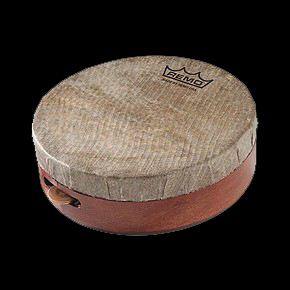  
Kanjira is
one of the main percussion instruments of the
Carnatic classical music system. It is a relatively recent
addition with its status elevated to solo instrument by the genius of
the late Sri Hari Shankar and more recently
the masterful Selva Ganesh Vinayakram. The
shell of the kanjira is approximately 2
inches deep and the diameter of the shell is approximately 7 or 8 inches
wide. It is a single-headed lizard skin drum. The skin is stretched taut
over the shell and is glued on the outside of the shell. In this state
the drum is very highly tuned but in performance it needs to be very
bass orientated. This effect is achieved by lightly spreading water on
the head before and during the show. Itís very difficult to maintain the
desired pitch for a prolonged period of time so a
kanjira player will need to have any number of
kanjiras on stage with him. The drums are
at varying degrees of 'wetness' and are switched when of optimum tuning
for the bass tone. One alternative to this is the new tuneable kanjira,
part of Remoís world percussion range. One other very important
characteristic of the drum is the solitary pair of tiny brass
jingles fixed into a hole in the shell which adds a very sharp
cut to the sound.
The kanjira is probably the most difficult
Indian drum to be effective on because it is played with only one
hand, the role of the other hand being to support the drum and bend the
pitch with the fingertips. If we look at the holding positions, we can
see how this is achieved. If we look at the drum as if it were a clock
face, we can see that the left hand is supporting the drum at
6 oíclock with the fingers in front of the drum in a vice like
grip. The thumb comes around inside the shell. (I have recently changed
my own grip which previously had the thumb along the outside edge at the
back of the shell.) We can see how the fingertips come around underneath
the shell and touch the head just at the edge. Itís by squeezing here
that we achieve the pitch bend. This is aided by a very
steep bearing edge inside the drum.
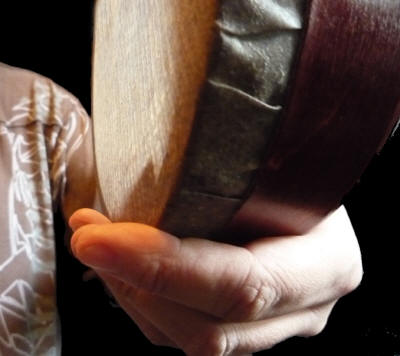 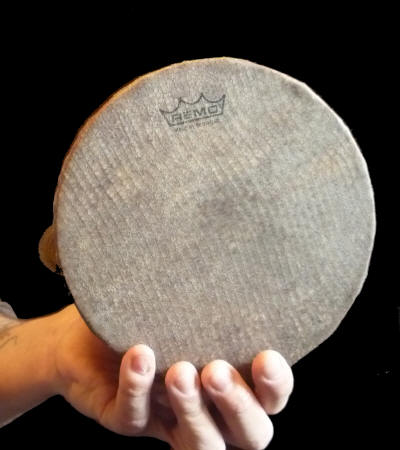
Holding position Holding position at front of drum
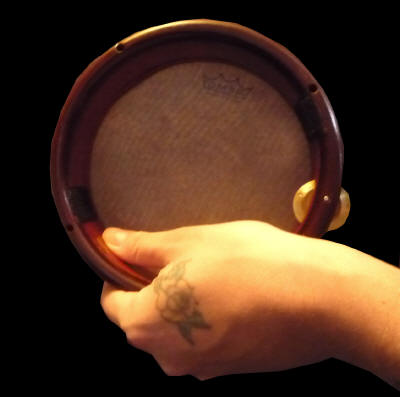
Holding position inside drum
The way the striking hand is used is common
to almost all Indian hand drums. It
involves splitting the fingers into two striking units. The one fingered
striking unit with the first finger and a unit involving the second,
third and fourth fingers joined together. Although these are the
striking units, they both strike individually with the hand in a normal
position, NOT with the hand split into a 'V'
as below.
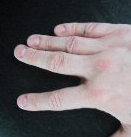
Our first stroke will be
'Ta' This is a closed non-resonant sound
played with either the one fingered striking unit flat in the centre of
the drum or the three fingered striking unit flat in the centre of the
drum. The Ta sound is a sharp
staccato sound similar to a crisp but delicate slap on a conga.
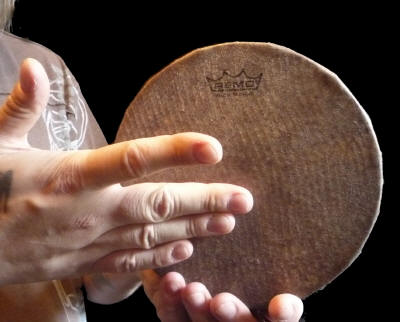
Three fingered closed stroke front view
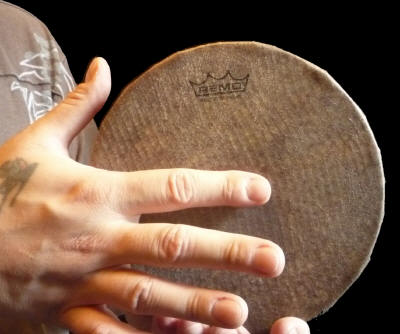
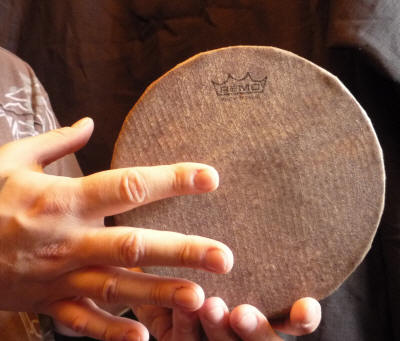
One fingered closed stroke
Open 'TUM' stroke with first finger
Our second stroke will be
'Tum' This is the open bass sound and
is played with striking unit one. The left hand fingers should not be
dampening the sound, but the drum must continue to be held firmly. The
striking finger should hit the head flat and move away from the head
immediately allowing the drum to ring. Bear in mind that the finger
should always travel in a straight line to attack the drum and not at an
angle. The hand should move in towards the centre for the
'Ta' sounds and out towards the edge slightly for the open
'Tum' sound.
Iíll
briefly talk about the ambiguity of some of the phonetics. The main drum
in Carnatic music is the
mridangam, a double-headed barrel drum. It
is from this drum that a lot of the phonetics are assumed. There are
dozens of sounds, each of which mean something different on the
mridangam. Drums such as the kanjira have
been introduced more recently in traditional South
Indian music but have employed the same phonetic language,
although the possible stroke combinations and different sounds are not
available on the drum. This means that a range of complex phonetics are
represented by a simpler set of strokes on the drum. This leads to
a lot of ambiguity regarding syllable representation on the instrument.
It is up the kanjira playerís knowledge of how the phrases would sound
on the mridangam and other classical drums
such as Thavil, and his intuition in
interpreting them for the kanjira.
The notation system I am employing is
very simple and on two lines only. The bottom line is always
the open 'tum' sound whilst the notes in
the middle of the stave are either the three fingered or one fingered
'ta' sound. The syllables are also included on some
examples.
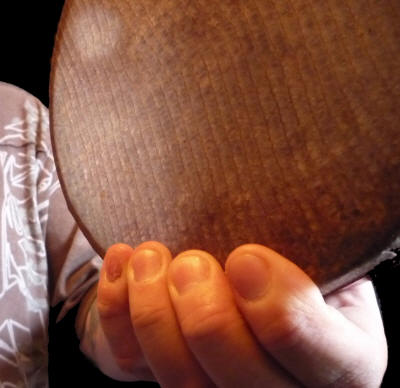
This is where the left hand fingers bend the
drum head for glissando
| Basic closed strokes with accents |
Our first pattern requires a simple
accent pattern using only the closed 'ta'
sound with both the three and one fingered units.

Accent pattern one.
Click to enlarge AUDIO
AUDIO


Accent pattern two..
Click to enlarge

Accent pattern three.
Click to enlarge AUDIO
AUDIO
 (#'s 2 & 3)
(#'s 2 & 3)
Any trouble printing, right click, save target as and then print from
the file saved on your hard drive.
| Closed strokes with accents &
open tones |
Our next patterns require the
introduction of the open 'Tum' sound with
the first finger.

Introducing the 'Tum'
sound.. Click to enlarge AUDIO
AUDIO


Basic groove involving 'Tum'
& 'Ta' Click to enlarge AUDIO
AUDIO

Our next pattern requires the
introductions of sixteenths using only the
closed 'ta' sound fingered
1/3/1/3. This is the characteristic fast rolling you hear
from Kanjira players. The speed they
can get this up to is amazing!

Introduction of sixtenth
notes. . Click to enlarge AUDIO
AUDIO

Here are some basic fingerings of the five beat unit,
'ta ti ki da tum' The phrase is manipulated int 6, 7, 8 and 9
beat units by the addition of gaps.
Five beat unit ta ti ki
da tum, Fingered 3 1 3 3 1
Six beat unit ta
ti - ki da tum, Fingered 3 1 - 3 3 1
Seven beat unit
ta - ti - ki da tum, Fingered 3 - 1 - 3 3 1
Eight beat unit ta
ti - ki - da - tum, Fingered 3 1 - 3 - 3 - 1
Nine beat unit ta
- ti - ki - da - tum, Fingered 3 - 1 - 3 - 3 - 1

|
